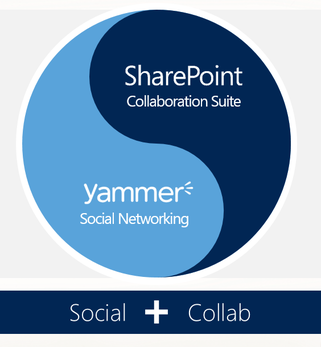
At its core, Yammer is a micro-blogging service for employees to provide short status updates. Whereas Twitter asks, “What’s happening?” Yammer asks, “What are you working on?”
Over the years, Yammer’s functional services have expanded a bit to include the ability to express praise for co-workers, create polls, share documents and provision smaller discussion groups. In practice, however, some of those supplementary services aren’t as rich or well-integrated into SharePoint as you might find in competing products.
And you can find a lot of competing products: from collaboration suites that offer tightly integrated social networking services to supplemental “social layer” offerings that compete directly with Yammer.
For this reason, it would be good to ask this question: Is Yammer truly the best social layer for your enterprise?
When Microsoft acquired Yammer shortly before releasing SharePoint 2013, the deal sent shock waves through the marketplace. Soon Microsoft started recommending that you hide SharePoint’s native social services in SharePoint and use Yammer instead.
Microsoft now promotes Yammer as a social layer over all your Microsoft systems, especially Office 365. Yammer usage can explode within an enterprise that heretofore offered no micro-blogging services, let alone any enterprise social network. People happily check in and often find new or long-lost colleagues in the first few days and weeks.
Yammer boasts a huge customer community. Customers get access to the quite sizable Yammer Community Network, where licensees share their successes, problems, questions and tips with the community as a whole. A small but growing apps marketplace rounds out the picture of a vibrant ecosystem around Yammer.
Smaller departments use Yammer to stay in touch, but enterprise-wide conversations typically decrease. Usage also drops off when employees struggle to place the service within the regular flow of their daily work. Yammer becomes yet another place you have to go, rather than a service you exploit as part of your regular workflow.
In a mobile environment, Yammer and SharePoint usage entails at least two separate native clients.
Yammer has key application: social questions and answers. When a user starts to type a question, Yammer uses a real-time search to auto-suggest already asked questions. That is useful and helps to eliminate duplication in content.
However, there are no ratings for answers and the original questioner cannot declare an authoritative answer. Search is not really ideal, so as answers build, they become harder to leverage, especially given the scarcity of curation services. Yammer works less for knowledge management and more for really simple, quick responses to simple questions.
Another Yammer key social application: communities of practice. Groups are either public or private. You might also have separate groups in Exchange and SharePoint (via Delve), as well as Communities in SharePoint.
There is single sign-on to Yammer with Office 365.
Larger enterprises find Yammer better suited as a supplement to formal collaboration and social networking efforts rather than as the center. Its simplistic handling of files and limited search facilities limit Yammer’s ability to serve as much more than a simple micro-blogging service.
If you are looking for pure micro-blogging services to communicate across your enterprise and are not looking for ready-to-use applications tailored for specific goals and processes, Yammer offers an obvious alternative to consider, especially for those whose SharePoint plans rest primarily on the Office 365 edition.
Galaxy Consulting has experience with all versions of SharePoint and with Yammer. Please contact us today for a free consultation.
 RSS Feed
RSS Feed
